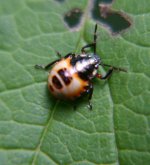harry eales
Ancient Entomologist
Colin said:Stranger/Mexican,
Thanks for the replies. This is a strange one. It seems with several of the warmer months gone (August tomorrow) I have suddenly realised that I have seen almost no Ladybirds this year. It's not a case of a dwindling supply but virtually none at all, all year. Can't think it can be the intruders otherwise I would have seen them. Maybe it is the lack of food?
Hello Colin,
I don't think it's the lack of Aphids (the commonest Ladybird Food) that is the problem. I have thousands of Aphids covering most of the foodplants I feed the larvae of Lepidoptera I am breeding. Many Ladybird species only have one life cycle a year and a good number of them I have seen recently, are in the pupal stage at the moment. If you try a little 'Beating' in the next few weeks or so, I think that you will find there is a good abundance of Ladybird species about.
Harry





